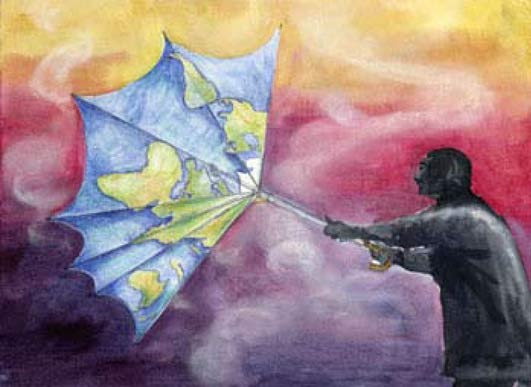Despite a wide range of events/subjects playing out on this federal-holiday Monday afternoon, one item related to climate change caught my eye during InterWeb surfing — ‘doom-scrolling‘ called by some — and is within context of how our warming environment will eventually create an uninhabitable setting near-immediately for most living things, incuding humans.
Invoke a kind of freakish, weird, migration domino-effect, based on dead lands.
People, water and air influenced by wicked heat:
An excellent explanation. “Wet Bulb temperature is the scariest part of climate change you’ve never heard of” by Tim Andersen, Ph.D.https://t.co/hrU9ES0rLj
— Matthew Greenfield (@mattgreenfield) July 5, 2021
Location is a direct factor as this ‘wet-bulb temperature’ had no real effect on that horrid heat wave last week in the NW US and Canada — a dry heat wave vs a very humid heat wave, like a similar event taking place in the SE US would be a society-changing catastrophic moment in history.
A good read on this ‘wet-bulb’ phenomenon is by Tim Anderson, author of “The Infinite Universe, A First Principles Guide,” and conducts research in general relativity and quantum field theory at Georgia Tech, and found at Medium from last Friday, ‘Wet-bulb’ an unsung villain — some snips:
Wet bulb temperature is one of those features of climate change caused by global warming that often gets left out when discussing the radical changes our planet is going to experience in the coming years.
Discussion has largely focused on issues such as drought, hurricanes, tornadoes, storm activity, and even unusual cold.
The impacts of increased heat have been left out because we assume, incorrectly it turns out, that human beings can adapt to moderate increases in global temperature.
This turns out to be false, particularly in areas prone to hot and humid weather.
It all comes down to one measure: wet bulb temperature. Wet bulb temperature is the one factor, more than any other, that can render entire regions uninhabitable.
…
At 100-percent humidity, the dry and wet bulb temperatures will be the same. Otherwise, the wet bulb temperature will always be lower than the dry bulb. This means that, while dry places do tend to get very hot, they are also very good places to use evaporative cooling.
Humid regions, on the other hand, can only get so hot before evaporative cooling breaks down.
The reason it is important is because human beings and other warm blooded animals rely on being able to release heat into the air through sweating, panting, or other means, releasing water in the process.
…
While triple digit dry bulb temperatures are frightening, until it gets up into the 120s F (49 C), people in dry regions can seek shelter and, because of the air’s near infinite capacity to absorb water, survive.
Humid regions, however, can have wet bulb temperatures in the mid-80s F (26–32 C) with only moderately higher dry bulb temperatures which is sufficient to kill vulnerable people such as the elderly.
For example, heat waves in Europe in 2003 and Russia in 2010 killed thousands with wet bulb temperature about about 82 F (27 C).
Wet bulb temperatures that are too close to the body’s own internal temperature can cause death within a few hours by overheating.
This happens even if the person is in the shade, without clothes, and using a fan. Unless they have a compressor-based air conditioner to cool and dry the ambient air, they will die.
When heat from sunlight is included, the problem is even worse.Not only bad for the effected area, but everywhere: What this means is that those regions will become empty of people and those people will need to go somewhere cooler. In some cases, this could create a significant refugee crisis.
Read the whole thing, etc., interesting, though, historically troubling…
Yet maybe I need to just chill::
‘Relax … relax ...’
 (Illustration out front from the UN’s International Children’s Painting Competition, and found here).
(Illustration out front from the UN’s International Children’s Painting Competition, and found here).